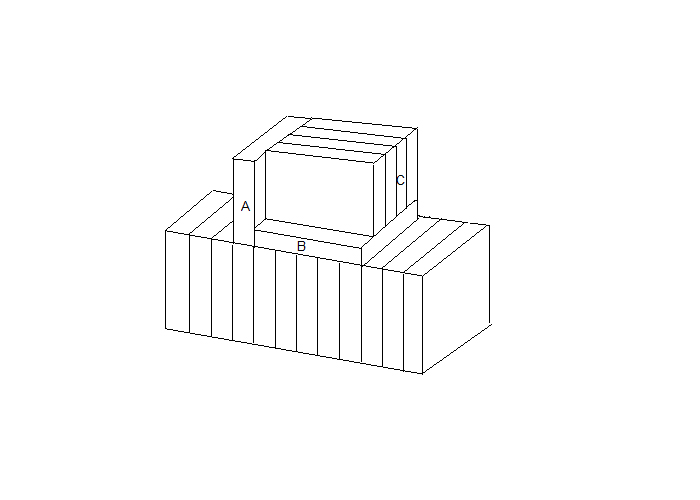Spatial Relations – Blocks and Touching Blocks
- Posted by Brian Stocker
- Date June 28, 2023
- Comments 4 comments
Blocks and Touching Blocks Practice
Touching Blocks
Touching Blocks questions give a complex image of blocks and you are asked to count the number of blocks a given block is touching.
Blocks – Cubes
Blocks questions present a complex geometric figure made of a series of rectangular or square blocks. You are asked the number of blocks in the figure.
Choose your Test
Touching Blocks Practice Questions
1. How many blocks is block A touching?
a. 4
b. 5
c. 6
d. 7
2. How many blocks is block B touching?
a. 4
b. 5
c. 9
d. 10
3. How many blocks is block C touching?
a. 4
b. 3
c. 2
d. 1
Blocks (Cubes)
1. How many cubes are there in the figure?
a. 30
b. 32
c. 35
d. 24
2. How many cubes are there in the figure?
a. 30
b. 22
c. 15
d. 24
3. How many cubes must we add in the figure to form a perfect cube?
a. 55
b. 45
c. 70
d. 125
Answer Key
Touching Blocks
1. C
Block A touches 6 blocks (1 is below, 4 are lateral in vertical position and 1 is lateral in the horizontal position.
2. D
Block B touches 5 blocks below, 4 blocks above and one block laterally, i.e. in total 10 blocks.
3. A
Block C touches 4 blocks in total: 1 below, 2 blocks laterally on the wider side and one block laterally, in the narrower side.
Blocks
1. C
In the bottom row, there are 3 × 4 + 3 = 15 cubes.
In the next row, there are 2 + 3 + 3 + 3 + 1 = 12 cubes.
In the third row, there are 2 + 2 = 4 cubes.
In the upper row, there are only 2 cubes.
Thus, in total there are 15 + 12 + 4 + 2 = 33 cubes.
2. D
From the figure, you will see that there are 4 + 4 + 2 + 3 + 3
= 16 cubes in the bottom row, 2 + 1 + 2 + 1 = 6 cubes in the
middle row and only 2 cubes in the upper row.
Thus, in total there are 16 + 6 + 2 = 24 cubes in the figure.
3. C
Since there are 5 cubes in the longest row, we need 5 × 5 × 5 = 125 cubes in total to form a perfect cube.
First, let’s count the existing cubes. In the first row, there are 5 + 4 + 5 + 5 + 4 = 23 cubes.
In the second row, there are 5 + 3 + 4 + 4 + 1 = 17 cubes.
In the third row, there are 3 + 3 + 2 = 8 cubes.
In the fourth row, there are 3 + 3 + 1 = 7 cubes.
Thus, in total there are 23 + 17 + 8 + 7 = 55 cubes.
Hence, we must add 125 – 55 = 70 cubes to form a perfect big cube.
Common Mistakes Answering Spatial Relations – Blocks Questions
Ignoring 3D: Remember you are working in 3 dimensions! Make sure you count all the surfaces that are touching – front, back, top, bottom, left and right.
Watch for hidden blocks: Blocks may be partially hidden or obscured from view.
Assuming blocks are uniform: Not all blocks are uniform in size or shape.
Rushing: As with any type of question – rushing will cost you marks! Counting blocks questions require very careful attention to detail. Work systematically through the questions. Don’t rush but don’t hang around either.
Spatial Relations Practice and Workbook
Spatial relations (visual acuity) practice questions including:
- Folding and Rotating
- Assembly
- Line Following
- Touching Blocks
- Blocks
- Cut Outs
- Jigsaw
- Matching Shapes
- Visual Comparison
Written by: Brian Stocker MA.
Publised by: Complete Test Preparation Inc.
Updated: Monday, December 22nd, 2025
Published: Wednesday, June 28th, 2023
Got a Question? Email me anytime - Brian@test-preparation.ca
You may also like
Toolbox Math – Basic Math for Trades
Basic Math Practice Questions for Canadian Trades Trades Entrance Canada Trades Alberta Trades Skilled Trades Readiness
CELPIP Writing Prompts
The CELPIP writing evaluates your ability to communicate effectively in written English different tasks. Here are some sample CELPIP Writing prompts for writing an exmail. You are given a prompt and a scenario. Your email may be formal or informal, …
CCAT Vocabulary Practice – Grades 4 – 5
1. What is the definition of the word ‘polygon’? a. A curved line b. A straight line c. A closed plane figure with straight sides d. A round shape 2. Which term means to ‘depict or show something’? a. Represent …








4 Comments
Can you show the solution diagram for the cubes questions we I can visualize?
3. How many cubes must we add in the figure to form a perfect cube?
The correct answer is 36! Review and fix the issue!
The question is correct. Take the total number of cubes for a complete cube (5 X 5 X 5 = 125) and subtract the number of cubes in the figure (55) to get the number of cubes to make a complete cube.
So 125 – 55 = 70
do you have more? and tutorials?